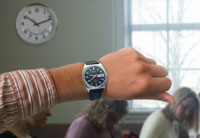Campus to be on time by fall
Photo illustration by Josh Harding
 By Ashley Thiesen By Ashley Thiesen
The Collegian
Time is not ticking very fast.
In fact in many Fresno State classrooms, time stands still.
As students and teachers pass by the clock tower between the University Student Union and the Kennel Bookstore, they will notice all four sides of the clock are not set on the same time.
But help is on the way to synchronize the clocks and keep them running for years to come, assistant director of Plant Operations Rick Finden said.
Earlier this semester, Fresno State received a quote from Primex Wireless Clock System for a $17,000 transmitter to keep the clocks running on a specific time throughout the whole campus. Primex is a company that sells wireless clocks that receive time signals from global positioning system satellites.
“It is critical for us to keep the clocks running,” Finden said. “The clocks have a major impact on everyone.”
Plant Operations has teamed up with the Alumni Association to pay for the new clock system. The Association has contributed between $8,000 and $10,000 to the project, Finden said.
Plant Operations is hoping to start installing the new clocks in a couple of months and have the whole campus up and running by September 2006.
“We are looking forward to seeing the new clocks going up after winter break,” Finden said.
Until then, students and teachers are going to have to bring their own time to the classroom.
Debby Gamez, administrative assistant for the mass communication and journalism department, said teachers come to her to place a work order form and after she receives the order she hands it over to Plant Operations.
“We finally ended up ordering three clocks on our own for the department,” Gamez said. “We have wires coming out of the walls with a clock, but it still does not work.”
According to Primex’s Web site, “schools pay a steep price for clocks that do not keep the right time or the same time.”
The Web site says the new clock system will save the school between $10,000 and $15,000
versus the time and amount of money spent on the university’s current system.
“Right now we have to manually change the batteries out of an estimated 1,000 clocks twice a year,” Finden said. “That is about 230 hours to change the clocks.”
According to the university’s handout map there are 119 buildings on campus.
“We just don’t know how many are not working,” Finden said, “but we estimate there are about 3,000 clocks on campus.”
Melissa Gibson, assistant professor in the theater arts department, said clocks are vital to her classroom because they help keep her focused on what she needs to say to students.
“It looks rude to keep looking at my watch,” Gibson said. “It seems like I’m more concerned at the time than what they are actually saying.”
Robby Case, a junior majoring in recreation, finds the clock situation “kind of annoying.
“I see lots of teachers looking at the wall then at their watch. So it does draw attention to how much time is left,” Case said.
Four out of five of the rooms he takes classes in do not have a working clock.
“I believe that fixing the clocks is on the bottom of their priority list,” Case said.
But Finden said that is not the case.
For years the clocks around campus have not worked properly. Each building has its own system and Plant Operations has a difficult time trying to keep up with repairs.
“As soon as we get a report that a clock is not working, we take immediate action,” Finden said. “We just haven’t been as responsive as we would like because we were down several people and it has been hard trying to find parts for the broken systems.”
The first clock systems were installed in the late 1950s while the campus buildings were being built, Finden said.
“The problem has just gotten worse in the last year or two,” he said.
Genie Montanye, administrative support coordinator for the department of political science and women’s studies, has worked on campus for almost 20 years. She says the clocks have never been on time.
“The clocks have been a problem for the last 10 to 15 years,” Montanye said. “The clocks are important for faculty and students to have to get to class and meetings on time.”
During his classes, Case has to pull out his phone to check the time.
“Time is definitely important,” he said. “I do not have much time in between my classes.”
Comment on this story in the News forum >>
|
